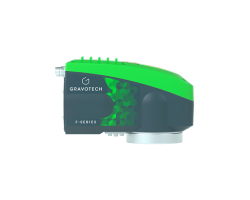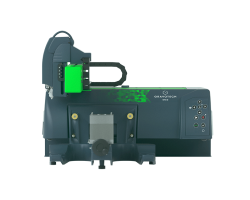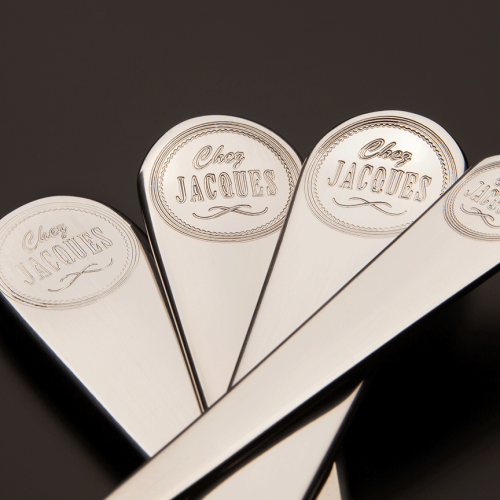Stainless steel is one of the most widely used metals in many industries. Due to its excellent properties, stainless steel has become indispensable in the composition of parts for medical, tooling, aeronautics, automotive, consumer goods, cutlery, jewelry, signage, etc.
In addition to its corrosion resistance, stainless steel is a bright, durable, and versatile metal resistant to acid attacks, and most cleaning and sterilization treatments.
Stainless steel engraving is a process that represents a high added value for identification and traceability but also personalization applications.
Our engraving & marking machines for stainless steel
Several marking methods are possible. Our stainless steel laser engraver range offers surface thermal markings that are highly corrosion-resistant, deep, and high-contrast without causing stress, material deformation, or creating weak points.
Suitable for both industrial part identification and personalized engravings, laser technology ensures durability and clarity, enhancing traceability and adding value to products.
- Integrable lasers: such as the Fiber, Hybrid, and Green lasers, offer corrosion-resistant and high-contrast markings for high-speed production lines.
- Laser stations: the WeLase™, LW2, and LW3 stainless steel laser engravers can safely mark thanks to their class 1 laser protective enclosures.
Do you have a CO2 laser engraver ? If so, it’s still possible for you to engrave metal thanks to our Metal marker G.
Integrated laser system to mark and engrave on all metals.

FIBER Laser
Medium fully automated laser marking station.

LW2
Large fully automated laser workstation with Fiber, Hybrid or Green sources

LW3
Small laser engraver for all kind of engravings.

WELASE
Integrated laser system for high quality marking on plastics and metals.

HYBRID Laser
Integrated laser system for high quality and cold marking on plastics and precious metals.

GREEN Laser
Dot peen marking machines and scribing solutions provide fast, accurate, and deep markings for your industrial applications.
- Pneumatic and electromagnetic dot peen marking
Dot peen technology uses a stylus to create precise, permanent indentations, ensuring tamper-proof identification ideal for industrial traceability. This technology is available on the Impact, XF510p, XF510m and XF530 for fast, accurate texts or datamatrix codes. - Scribing marking
Scribing employs a diamond-tipped tool to etch smooth, continuous lines, producing clear, high-quality marks with minimal noise—a significant advantage in noise-sensitive environments. This technology is used by the XF510r and SV530 for discreet alphanumerical markings.
Standalone dot peen marking station.

IMPACT
The most precise and consistent electromagnetic dot peen marking machine.

XF510m
The quiet metal scribing marking machine.

XF510r
The fastest pneumatic dot peen marking machine.

XF510p
Deep and permanent dot peen marking system.

XF530 p/m
The VIN scribing marking machine.

SV530
The versatility stainless steel engraving machines allows for the personalization of gifts—transforming ordinary items into cherished keepsakes—and the meticulous marking of industrial parts, ensuring traceability and compliance.
With the ability to handle various materials, including metals, plastics, glass, stone, and more, these machines cater to both creative endeavors and industrial demands.
- Rotary engraving machines like the M20 X and M40, are the artisans of the engraving world. They gracefully etch intricate designs and precise identifications onto stainless steel.
- CNC engraving machines, such as the IS200, IS400, and ISx000, offer precise and attractive engraving across a range of markets working with stainless steel.
Small and custom engraving machine for all purposes, from perfume bottle to small industrial signage.

M20 X
Medium multi-purpose rotary engraving machine for signage and gifts.

M40
Small CNC engraving machine for label and small part traceability system.

IS200
Medium CNC engraving machine for flat and cylinder engraving on metal and plastic.

IS400 and IS400 Volume
Large and extra large format CNC engraving machines.

ISx000

Marking challenges
on a durable material
Stainless steel etching and marking require advanced technology to ensure high-quality results. Stainless steel is prized for its durability, resistance to corrosion, and esthetic appeal, but these properties make it challenging to mark effectively. Its hardness can wear down traditional tools quickly, while its reflective surface may pose difficulties for certain marking methods.
Gravotech’s advanced machines, like laser and dot peen marking machines, are designed to tackle these challenges head-on. They deliver precise, permanent marks without compromising the material’s integrity. This ensures that the marks remain legible and resilient, even in the case of exposure to high temperatures, corrosive substances, sterilization processes, or harsh environments. And this, throughout the entirety of the part’s lifecycle.
Whether it’s a datamatrix on an industrial component or a personalized engraving on a reusable bottle, Gravotech guarantees that your marks will endure.
Stainless steel marking and engraving methods

Stainless steel engraving
with a laser
Stainless steel laser engravers usually produce results through two main techniques: black marking (annealing) and deep engraving. The hardness of stainless steel does not interfere with stainless steel laser engraving.
Black marking involves heating the material just below its melting point to create oxide layers, resulting in a high-contrast, matte black mark. This non-abrasive process produces highly detailed and aesthetic markings without cracks or surface deformation.
It is ideal for applications requiring precision and durability, such as high-end consumer products and medical tools. By optimizing the laser beam parameters, a range of colors can also be achieved.
Deep engraving, on the other hand, removes material through multiple laser passes, creating legible and durable marks. This method is widely used in industrial settings where markings must withstand harsh environments and treatments like galvanization.
By using increased laser power and lower marking speeds, deep engraving ensures a permanent, high-contrast mark suitable for traceability and compliance requirements.

Stainless steel marking
with dot peen machines
Dot peen marking is a fast and reliable solution for stainless steel etching, ensuring permanent identification that withstands wear, corrosion, and harsh environments. Unlike certain other methods, it does not generate heat, preserving the integrity of the material and preventing structural weaknesses—making it ideal for industries like aerospace and automotive.
This method offers flexibility, allowing for both fine and deep markings depending on requirements. Pneumatic dot peen systems are perfect for high-speed industrial marking, while electromagnetic dot peen excels in precision applications like datamatrix codes.
The ability to mark even irregular surfaces ensures adaptability across various industries, making dot peen marking machines a trusted choice for durable stainless steel marking.

Stainless steel marking
with scribing machines
Scribing technology is a highly effective method for stainless steel marking, offering deep, precise, and permanent engraving. Using a carbide or diamond tip, the machine applies controlled pressure to create continuous, smooth lines instead of individual dots, as seen with dot peen marking machines. This results in a highly legible and aesthetically refined mark, making it ideal for applications where both traceability and branding are essential.
One of the key advantages of scribing is its quiet operation, making it particularly suitable for hollow or thin-walled stainless steel parts like tubes, metal sheets, and nameplates, where vibration must be minimized.
Additionally, scribing stainless steel engraving machines achieve a superior balance between marking speed and depth, ensuring durable, high-contrast engraving that withstands harsh environments. Whether used in heavy industries, automotive components, or equipment nameplates, scribing delivers resilient and professional-quality markings while maintaining the integrity of the stainless steel surface.

Stainless steel engraving
with rotary machines
Rotary engraving is a traditional yet highly effective method for stainless steel marking. Using cutting tools of various shapes and sizes, rotary stainless steel engraving machines can create deep, intricate designs with remarkable durability. This technique is particularly valued for its ability to engrave even the smallest and most detailed characters or logos, making it ideal for industrial traceability and artistic personalization.
One of the key advantages of rotary engraving is its ability to enhance the percieved quality of stainless steel, giving the final engraving a refined and polished appearance. Moreover, the constant and strong engraving depth allows you to add lacquer or paint afterward to further customize and highlight the design. Whether for mechanical workshops, jewelry, or industrial nameplates, rotary engraving remains a versatile and reliable choice.
Applications for industry and personalization
Stainless steel marking spans a wide range of applications:
- In industrial contexts
It ensures the traceability of components with serial numbers, barcodes, and 2d codes. For the medical sector, for example, it enables compliance with stringent regulatory requirements for the identification of tools and implants.
- In personalization contexts
In the consumer market, engraving transforms items like bottles, flasks, and cutlery into personalized gifts, adding emotional and perceived value.
Gravotech’s solutions adapt to both high-volume industrial needs and small-scale creative projects, delivering precise, durable results that enhance functionality and esthetics.





























